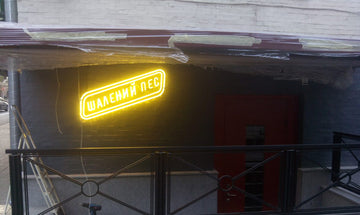Form
Neon will replicate the layout as closely as possible using 3 planes. The sharp corners will be slightly rounded (depending on the size), and the parts of the tube that should not glow are painted over. Neon is handmade, which means an error of up to 2 cm is possible. Below is how the transformation takes place from the customer supplied image to the final neon product. More examples in the current stories "On order" on our Instagram.
|
Output layout |
Technical layout in curves (vector) |
Visualization in neon |
Photo of the product |
Layout
It can be text, image or a combination of them. If it's an image, please send us a mockup, preferably in vector format (eg eps, ai, .svg). If it is not there, then an example or a freehand drawing will do.
Text
If it is text, write the word or phrase, specify the font(s). You can choose the right one on the website www.dafont.com. Below are the fonts we use frequently.
|
|
|
|
|
 |
 |
Depending on the font, complexity and dimensions, text can be done in neon in several ways.
|
A single neon tube |
Unbreakable single neon tube |
Double neon tube |
Parallel illumination of a large-scale sign |
Dimensions
We need to know one of the parameters - width or height. We calculate the second variable by proportion. If it is an inscription, then you can also specify the height of one of the letters and up to the lines. The size limit is only on the smaller side and depends on the complexity of the product. You should not place too many elements on a small area, because it can create a light spot. Below is an approximate visualization of the dimensions that can help you with your choice.

Color
You can read the list of colors and examples here. Images and photos do not convey the real glow of the tubes, so it is better to see "live". Availability needs to be confirmed. The tube can be transparent, with phosphor spraying or colored. Fluorescent glass in off mode has white light, and colored glass remains so*. A transparent tube can only have a red and blue glow (neon and argon, respectively).
*Possible "wash-out" on the sharp bends of the tube.
Types of installation
The installation can be fixed directly on the wall/ceiling or a pre-prepared substrate. More details and examples are in our separate article
Lining
Neon can be installed on a base made of transparent or colored acrylic, glass, PVC, metal strip, etc. Then it will be enough to hang the sign by a chain or "eye", like a picture, and connect it to an outlet. A mobile version of a sign for gifts or events. It does not always require the involvement of installation and electrical connection specialists. More details are in the corresponding section of our article.
Form and volume
The substrate can be made rectangular, oval, or according to the outline of neon. Volume can also be provided to hide the wires and transformer.
|
Transparent rectangular base |
Transparent round base |
Transparent base in the form of the inscription/image |
Color box |
Protective screen
If the sign is in a place where it can be caught or reached by hand, it is better to install a protective screen made of clear acrylic. On the street, you need to think about the protection of pipes from ice and snow from the roof, fruits of nearby trees, and vandalism.

Components
Type, location, and number of transformers
The type and number of transformers depend on: the diameter and length of the tubes, the number of components, the total length of the wire, and gas, and the place of operation (street or interior).
Electronic transformers are usually used indoors. Their length usually does not exceed 140 mm, and their weight is about 200 grams. The given characteristics are purely individual and depend on each specific model.
The transformer should be located within a radius of 1.2-1.5 m from the far ends of the sign, in an accessible place, from where it can be retrieved and replaced if necessary. In order not to stand out, it can be painted, for example, to match the color of the wall. To connect, you need a 220 outlet or a socket. It is desirable to lead the wire in the place where it was decided to place the transformer: so it will be less visible and it will not spoil the appearance. An even number (2 for each transformer) of transparent (or black) high-voltage wires will go from the transformer to the sign. The closer the transformer is to the sign, the fewer wires there are. Below are some examples of transformer placement.
|
Inside |
On the side |
On the top |
On the bottom |
The color of the light-blocking paint
The parts of the tube that should glow are painted over. The color of the light-blocking paint is usually chosen based on the color of the neon and the background behind it. Choice of black, white, and gray colors. In some cases, painting can be avoided if the font, size, or complexity of the part allows it. We inform you in advance about this possibility.
|
Black paint |
White paint |
Color of high-voltage and network wire, racks, insulators
The color of the wire between the neon parts and the transformer is also selectable, as are the silicone bushings for insulation. Clear and black colors are available. Usually, when choosing, they are guided by the color of the tube, paint, and the wall behind the neon. Plastic racks are often transparent.
|
Black wire and insulators |
Transparent wire and insulators |



























